题目1:线性可分SVM
代码:
import numpy as np
import scipy.io as sio
import matplotlib.pyplot as plt
from sklearn.svm import SVC
def plot_data():
plt.scatter(X[:, 0], X[:, 1], c=y.flatten(), cmap='jet') # 输出X的维度知道其特征数,再通过y来贴标签
plt.xlabel('x1')
plt.ylabel('y1')
def data_boundary(model, a1, a2, b1, b2):#画决策边界
x_min = a1 #-0.5
x_max = a2 #4.5
y_min = b1 #1.3
y_max = b2 #5
xx, yy = np.meshgrid(np.linspace(x_min, x_max, 500), np.linspace(y_min, y_max, 500))#从上述两个范围内各取500个点组成网格
z = model.predict(np.c_[xx.flatten(), yy.flatten()])#降成一维并组成二维数组
zz = z.reshape(xx.shape)#重塑成之前为维度,方便画图
plt.contour(xx, yy, zz)#绘制等高线
data = sio.loadmat('./data/ex6data1.mat')
print(data.keys())
X = data['X']
y = data['y']
print(X.shape)
print(y.shape)
plot_data()
plt.show()
svc1 = SVC(C=1, kernel='linear')
svc1.fit(X, y.flatten())
y_pred1 = svc1.predict(X)
y_score1 = svc1.score(X, y.flatten())
print(y_pred1)
print(y_score1)
data_boundary(svc1, -0.5, 4.5, 1.3, 5)
plot_data()
plt.show()
svc100 = SVC(C=100, kernel='linear')
svc100.fit(X, y.flatten())
y_pred100 = svc100.predict(X)
y_score100 = svc100.score(X, y.flatten())
print(y_pred100)
print(y_score100)
data_boundary(svc100, -0.5, 4.5, 1.3, 5)
plot_data()
plt.show()输出:
dict_keys(['__header__', '__version__', '__globals__', 'X', 'y'])
(51, 2)
(51, 1)
[1 1 1 1 1 1 1 1 1 1 1 1 1 1 1 1 1 1 1 1 0 0 0 0 0 0 0 0 0 0 0 0 0 0 0 0 0
0 0 0 0 0 0 0 0 0 0 0 0 0 0]
0.9803921568627451
[1 1 1 1 1 1 1 1 1 1 1 1 1 1 1 1 1 1 1 1 0 0 0 0 0 0 0 0 0 0 0 0 0 0 0 0 0
0 0 0 0 0 0 0 0 0 0 0 0 0 1]
1.0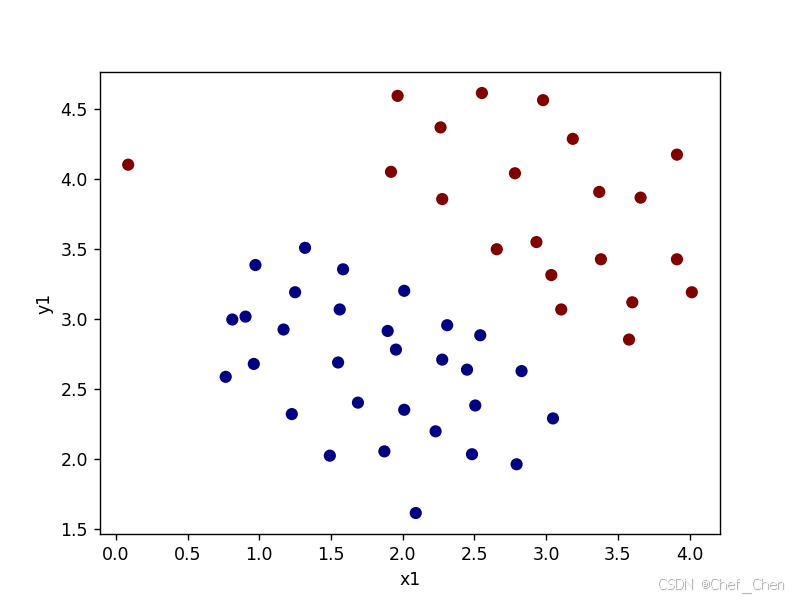
原始数据散点图
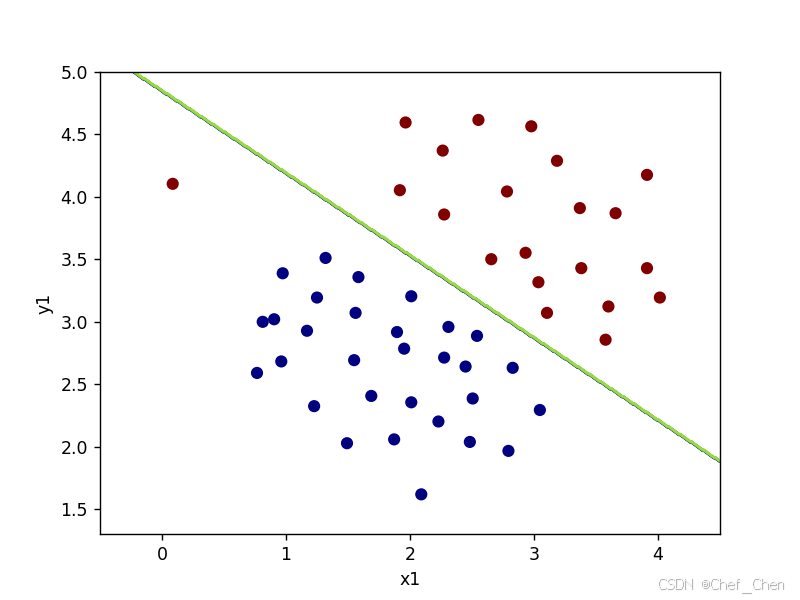
C=1时决策边界

C=1时决策边界
注意:虽然C为100时决策边界完美的把正负样本都分开来,但是此时准确度为100%,有可能左边这个点属于异常值,应该要被排除的,在实际运用中出现这种情况要警惕。
题目2:线性不可分SVM
代码:
import numpy as np
import scipy.io as sio
import matplotlib.pyplot as plt
from sklearn.svm import SVC
def plot_data():
plt.scatter(X[:, 0], X[:, 1], c=y.flatten(), cmap='jet') # 输出X的维度知道其特征数,再通过y来贴标签
plt.xlabel('x1')
plt.ylabel('y1')
def data_boundary(model, a1, a2, b1, b2):#画决策边界
x_min = a1 #0
x_max = a2 #1
y_min = b1 #0.4
y_max = b2 #1
xx, yy = np.meshgrid(np.linspace(x_min, x_max, 500), np.linspace(y_min, y_max, 500))#从上述两个范围内各取500个点组成网格
z = model.predict(np.c_[xx.flatten(), yy.flatten()])#降成一维并组成二维数组
zz = z.reshape(xx.shape)#重塑成之前为维度,方便画图
plt.contour(xx, yy, zz)#绘制等高线
data = sio.loadmat('./data/ex6data2.mat')
print(data.keys())
X = data['X']
y = data['y']
print(X.shape)
print(y.shape)
plot_data()
plt.show()
svc1 = SVC(C=1, kernel='rbf', gamma=50)
svc1.fit(X, y.flatten())
y_pred1 = svc1.predict(X)
y_score1 = svc1.score(X, y.flatten())
print(y_pred1)
print(y_score1)
data_boundary(svc1, 0, 1, 0.4, 1)
plot_data()
plt.show()输出:
dict_keys(['__header__', '__version__', '__globals__', 'X', 'y'])
(863, 2)
(863, 1)
[1 1 1 1 1 1 1 1 1 1 1 1 1 1 1 1 1 1 1 1 1 1 1 1 1 1 1 1 1 1 1 1 1 1 1 1 1
1 1 1 1 1 1 1 1 1 1 1 1 1 1 1 1 1 1 1 1 1 1 1 1 1 1 1 1 1 1 1 1 1 1 1 1 1
1 1 1 1 1 1 1 1 1 1 1 1 1 1 1 1 1 1 1 1 1 1 1 1 1 1 1 1 1 1 1 1 1 1 1 1 1
1 1 1 1 1 1 1 1 1 1 1 1 1 1 1 1 1 1 1 1 1 1 1 1 1 1 1 1 1 1 1 1 1 1 1 1 1
1 1 1 1 1 1 1 1 1 1 1 1 1 1 1 1 1 1 1 1 1 1 1 1 1 1 1 1 1 1 1 1 1 1 1 1 1
1 1 1 1 1 1 1 1 0 0 0 0 0 0 0 0 0 0 0 0 0 0 0 0 0 0 0 0 0 0 0 0 0 0 0 0 0
0 0 0 0 0 0 0 0 0 0 0 0 0 0 0 0 1 1 0 0 0 0 0 0 0 0 0 0 0 0 0 0 0 0 0 0 0
0 0 0 0 0 0 0 0 0 0 0 0 0 0 0 0 0 0 0 0 0 0 0 0 0 0 0 0 0 0 0 0 0 0 0 0 0
0 0 0 0 0 0 0 0 0 0 0 0 0 0 0 0 0 0 0 0 0 0 0 0 0 0 0 0 1 1 1 1 0 1 1 1 1
1 1 1 1 1 1 1 1 1 1 1 1 1 1 1 1 1 1 1 1 1 1 1 1 1 1 1 1 1 1 1 1 1 1 1 1 1
1 1 1 1 1 1 1 0 0 0 0 0 0 0 0 0 0 0 0 0 0 0 0 0 0 0 0 0 0 0 0 0 0 0 0 0 1
1 1 1 1 1 1 1 1 1 1 1 1 1 1 1 1 1 1 0 0 0 1 1 1 1 1 1 1 1 1 1 1 1 1 1 1 1
1 1 1 1 1 1 1 1 1 0 0 0 0 0 0 0 0 0 0 0 0 0 0 0 0 0 0 0 0 0 0 0 0 0 0 0 0
0 0 0 0 0 0 0 0 0 0 0 0 0 0 0 0 0 0 0 0 0 0 0 0 0 0 0 0 0 0 0 0 0 0 0 0 1
1 1 1 1 1 1 1 1 1 1 1 1 1 1 1 1 1 1 1 1 1 1 1 1 1 0 0 0 0 0 0 0 0 0 0 0 0
0 0 0 0 0 0 0 0 0 0 0 0 0 0 0 0 0 0 0 0 0 1 1 1 1 1 1 1 1 1 1 1 1 1 1 1 1
1 1 1 1 1 1 1 1 1 1 1 1 1 1 1 1 1 1 1 1 1 1 1 1 1 1 1 1 1 1 0 0 0 0 0 0 0
0 0 0 0 0 0 0 0 0 0 0 0 0 0 0 0 0 0 0 0 0 0 0 0 0 0 0 0 0 0 0 0 0 0 0 0 0
0 0 0 0 0 0 0 0 0 0 0 0 0 0 0 0 0 0 0 0 0 1 1 1 1 1 1 1 1 1 1 1 1 1 1 1 1
1 1 1 1 1 1 1 1 1 1 1 1 1 1 1 1 1 1 1 1 1 1 1 1 1 1 1 1 1 1 1 1 1 1 1 1 1
1 1 1 1 1 1 1 1 1 1 1 1 0 0 0 0 0 0 0 0 0 0 0 0 0 0 1 1 0 0 0 0 0 0 0 0 0
0 0 0 0 0 0 0 0 0 0 0 0 0 0 0 0 0 0 0 0 0 0 0 0 0 0 0 0 0 0 0 0 0 0 0 1 1
1 1 1 1 1 1 1 1 1 1 1 1 1 1 1 1 1 1 1 1 1 1 1 1 1 1 1 1 1 1 1 1 1 1 1 1 1
1 1 1 1 1 1 1 1 1 1 1 1]
0.9895712630359212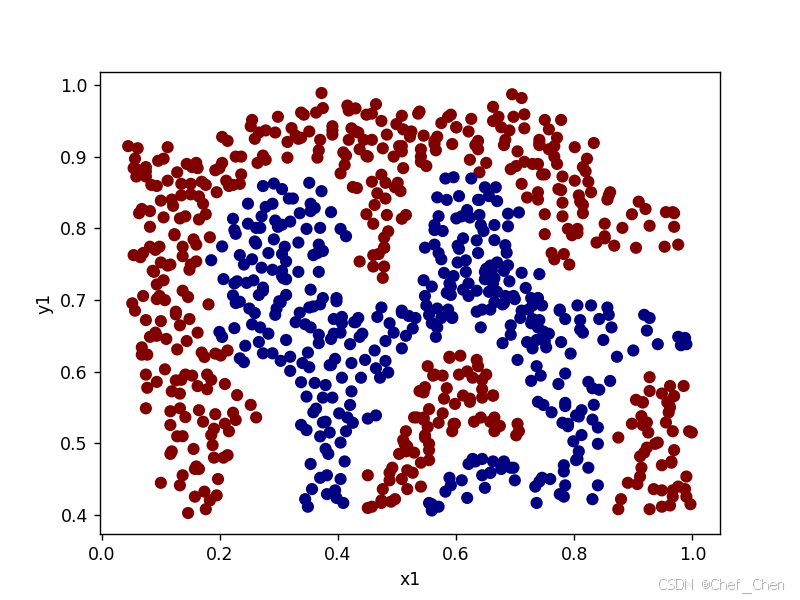
原始数据散点图
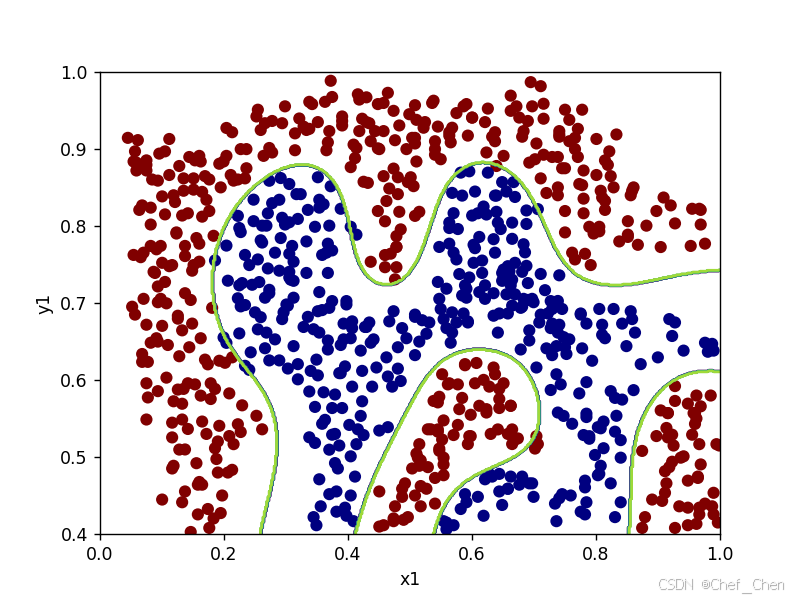
sigma=50时决策边界
题目3:寻找最优参数
代码:
import numpy as np
import scipy.io as sio
import matplotlib.pyplot as plt
from sklearn.svm import SVC
def plot_data():
plt.scatter(X[:, 0], X[:, 1], c=y.flatten(), cmap='jet') # 输出X的维度知道其特征数,再通过y来贴标签
plt.xlabel('x1')
plt.ylabel('y1')
def data_boundary(model, a1, a2, b1, b2):#画决策边界
x_min = a1 #0
x_max = a2 #1
y_min = b1 #0.4
y_max = b2 #1
xx, yy = np.meshgrid(np.linspace(x_min, x_max, 500), np.linspace(y_min, y_max, 500))#从上述两个范围内各取500个点组成网格
z = model.predict(np.c_[xx.flatten(), yy.flatten()])#降成一维并组成二维数组
zz = z.reshape(xx.shape)#重塑成之前为维度,方便画图
plt.contour(xx, yy, zz)#绘制等高线
data = sio.loadmat('./data/ex6data3.mat')
print(data.keys())
X = data['X']
y = data['y']
print(X.shape)
print(y.shape)
X_val = data['Xval']
y_val = data['yval']
plot_data()
plt.show()
C = [0.01, 0.03, 0.1, 0.3, 1, 3, 10, 30, 100]
sigmas = [0.01, 0.03, 0.1, 0.3, 1, 3, 10, 30, 100]
highest_score = 0
final_param = (0, 0)
for c in C:
for sigma in sigmas:
svc1 = SVC(C=c, kernel='rbf', gamma=sigma)
svc1.fit(X, y.flatten())
score = svc1.score(X_val, y_val.flatten())#训练好的参数在验证集预测
if score > highest_score:
highest_score =score
final_param = (c, sigma)
print(highest_score, final_param)#这里的最优参数组合不唯一,任意调整上述参数可选值的顺序会使其改变,但准确度大致不变
svc2 = SVC(C=1, kernel='rbf', gamma=100)
svc2.fit(X, y.flatten())
data_boundary(svc2, -0.6, 0.4, -0.7, 0.6)
plot_data()
plt.show()输出:
dict_keys(['__header__', '__version__', '__globals__', 'X', 'y', 'yval', 'Xval'])
(211, 2)
(211, 1)
0.965 (0.3, 100)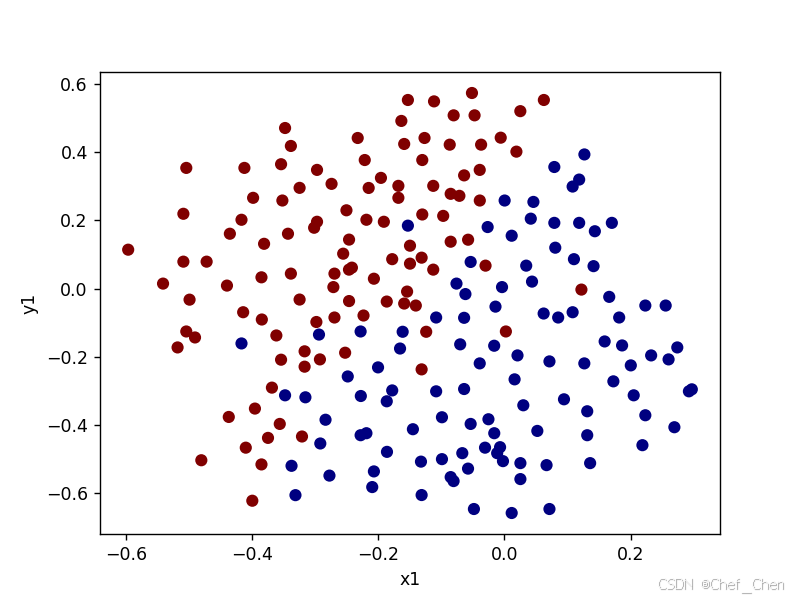
原始数据散点图
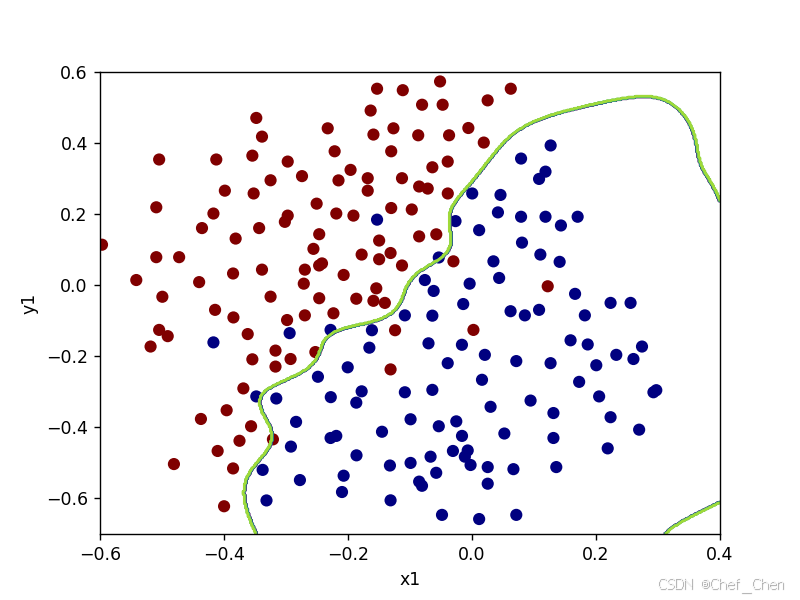
寻优后的决策边界
题目4:垃圾邮件过滤
代码:
import scipy.io as sio
from sklearn.svm import SVC
data1 = sio.loadmat('./data/spamTrain.mat')
print(data1.keys())
X = data1['X']
y = data1['y']
print(X.shape)
print(y.shape)
data2 = sio.loadmat('./data/spamTest.mat')
print(data2.keys())
X_test = data2['Xtest']
y_test = data2['ytest']
print(X_test.shape)
print(y_test.shape)
C = [0.01, 0.03, 0.1, 0.3, 1, 3, 10, 30, 100]
# sigmas = [0.01, 0.03, 0.1, 0.3, 1, 3, 10, 30, 100]
highest_score = 0
final_param = 0
for c in C:
svc = SVC(C=c, kernel='linear')
svc.fit(X, y.flatten())
score = svc.score(X_test, y_test.flatten())#训练好的参数在验证集预测
if score > highest_score:
highest_score = score
final_param = c
print(highest_score, final_param)#这里的最优参数组合不唯一,任意调整上述参数可选值的顺序会使其改变,但准确度大致不变
svc1 = SVC(C=final_param, kernel='linear')
svc1.fit(X, y.flatten())
score_train = svc1.score(X, y.flatten())
score_test = svc1.score(X_test, y_test.flatten())
print(score_train)
print(score_test)输出:
dict_keys(['__header__', '__version__', '__globals__', 'X', 'y'])
(4000, 1899)
(4000, 1)
dict_keys(['__header__', '__version__', '__globals__', 'Xtest', 'ytest'])
(1000, 1899)
(1000, 1)
0.99 0.03
0.99425
0.99总结:运用SVM可以帮助我们减少代码量和时间复杂度,但注意根据特征和数据集的数量选择核函数。